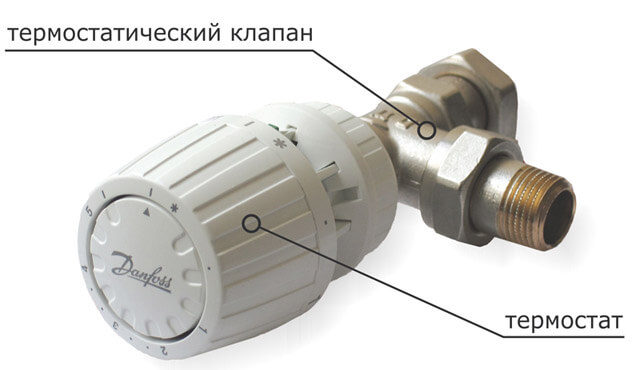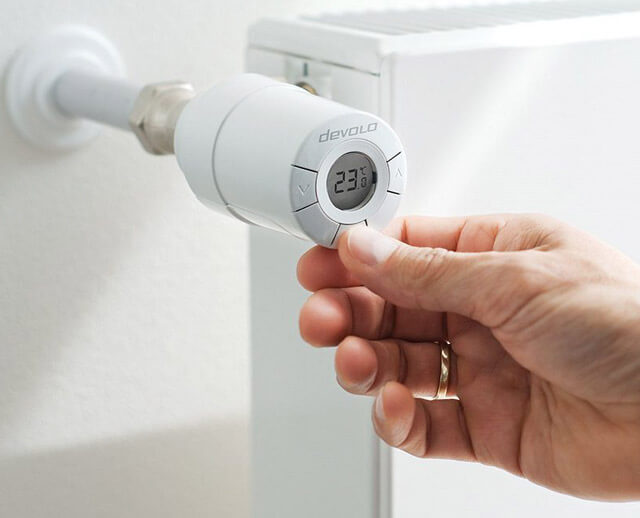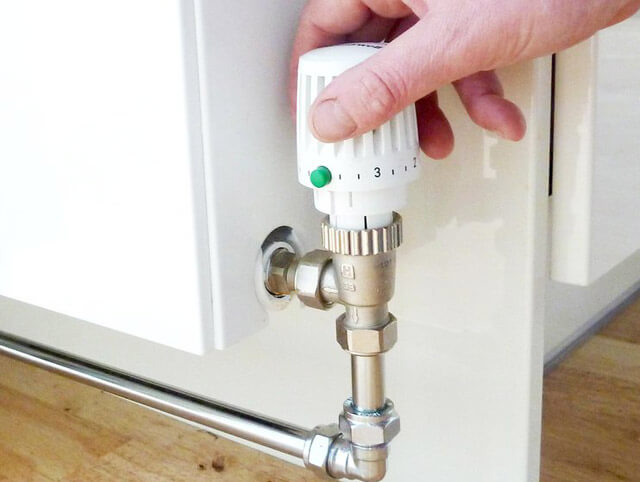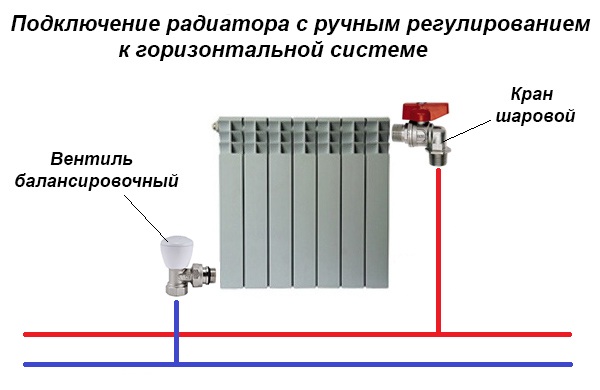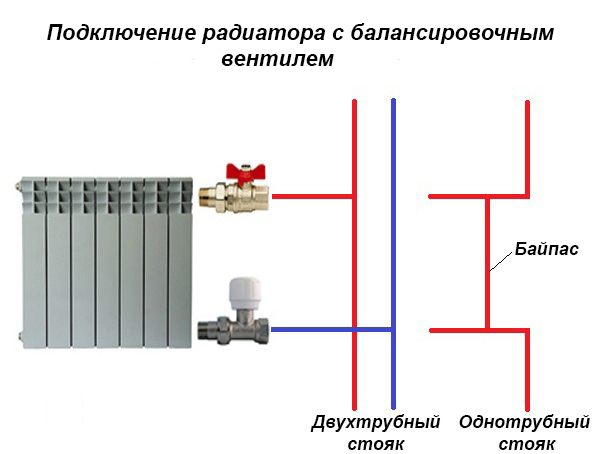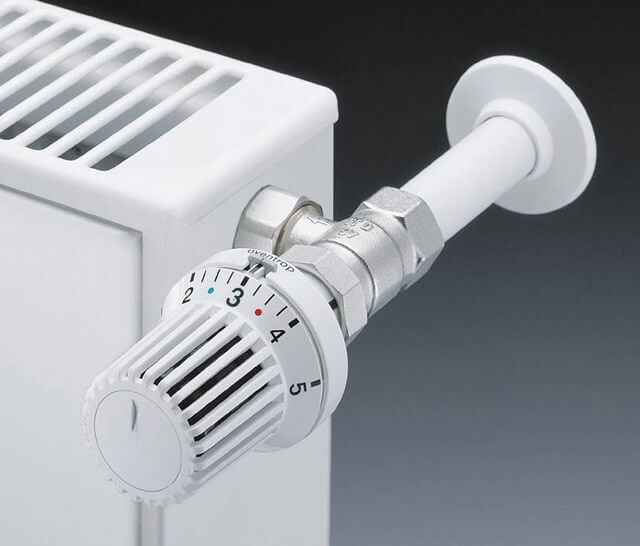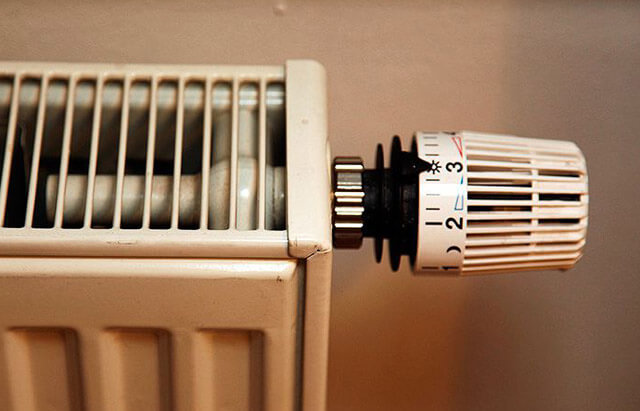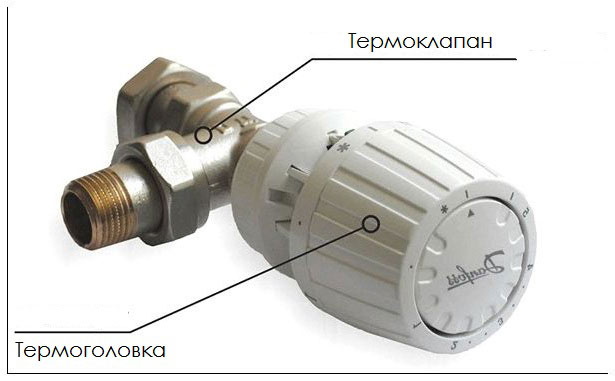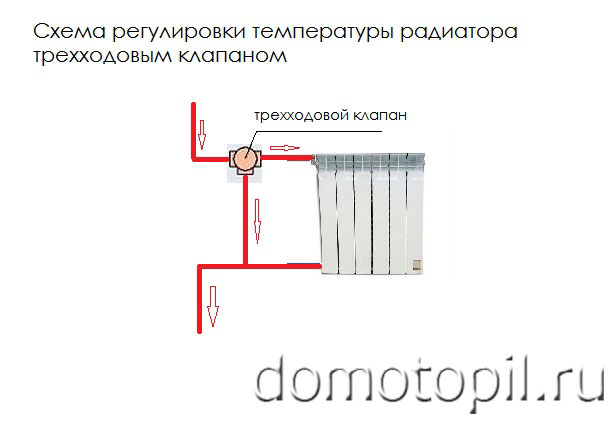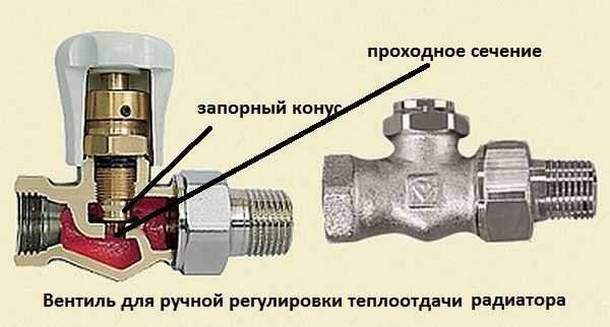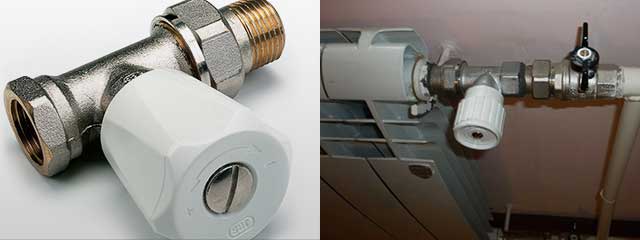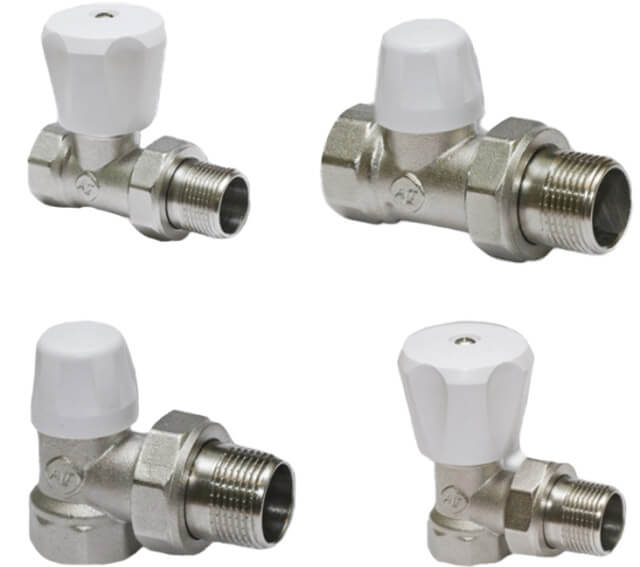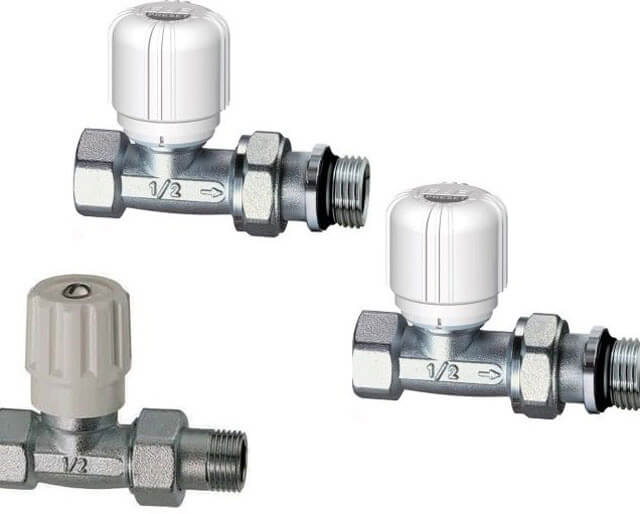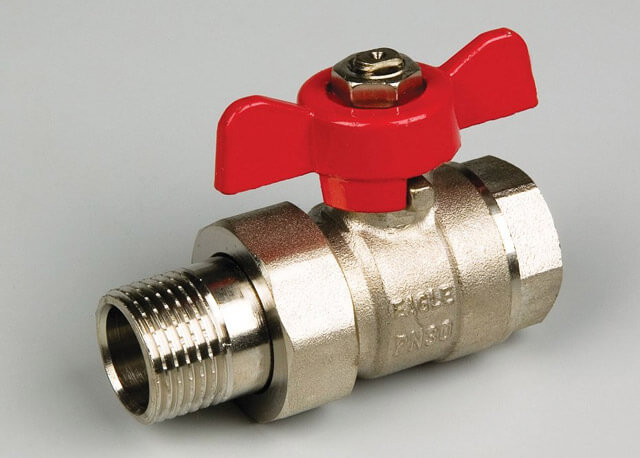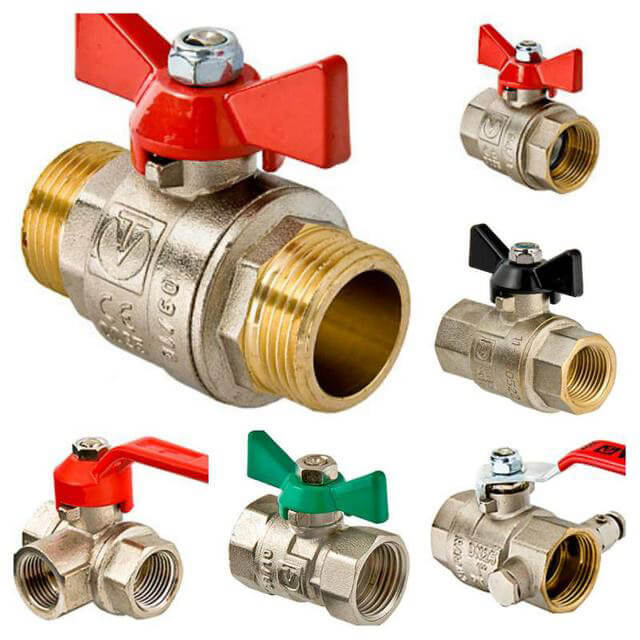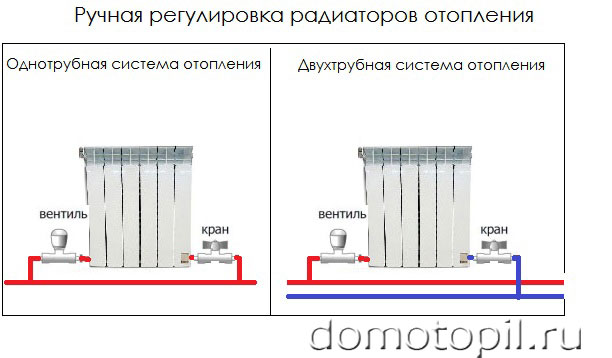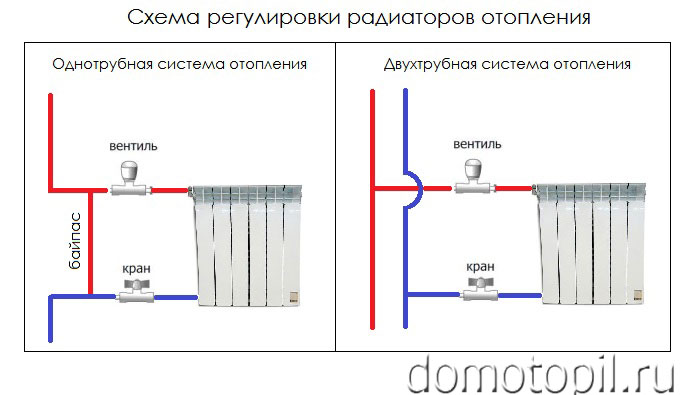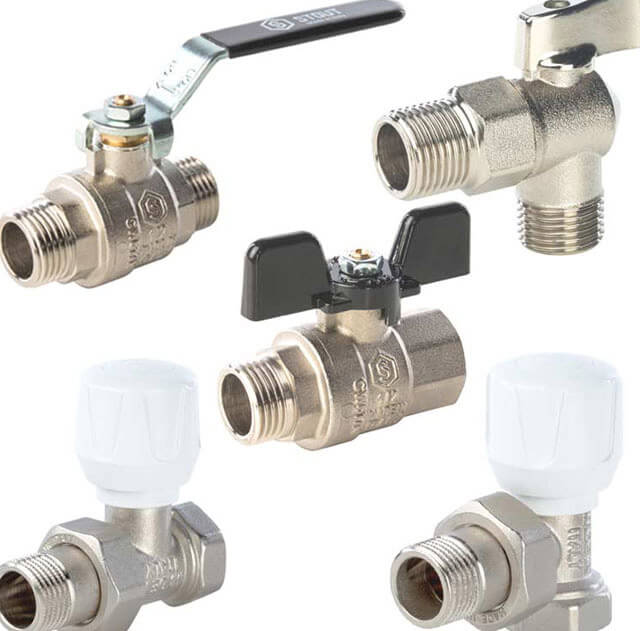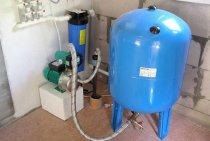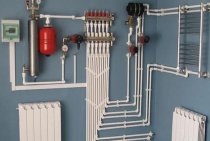Battery regulation with thermostat
To ensure constant maintenance of the set temperature in the room, use thermostats for radiators (thermostats). These devices have other names - thermostatic valve, thermostatic valve, etc. There are many names, but they all refer to the same product.
The thermal valve and thermal valve are the lower part of the device, and the thermal head and thermoelement are the upper ones. Most of these products work without power sources. The exception is models equipped with a digital screen, in which batteries are placed in the thermostatic head. You won't have to change them often, since the current consumption is negligible.
The radiator thermostat consists of several components:
- thermostatic valve, which is called the "case", "thermal valve", "thermal valve";
- thermostatic head or "thermostatic element", "thermocouple", "thermohead".
The body (valve) is made of metal, more often of bronze or brass. Outwardly, its design resembles a manual valve. Many manufacturers make the lower part of the radiator thermostat unified. This means that different types of heads can be mounted on one housing, regardless of their manufacturer.
Thus, it is allowed to install a thermoelement with different controls on the thermal valve - manual, mechanical or automatic, which is very convenient. If there is a desire to change the method of adjustment, there is no need to buy the entire device, you only need to install a different thermostatic element.
Automatic regulators differ in the principle of influencing the locking mechanism. In a manual device, its position is changed by turning the handle. As for automatic models, they usually have a siphon that puts pressure on a spring-loaded mechanism. In electronic products, the processor controls the workflow.
The bellows is the main element of the thermoelement (thermal head). It looks like a small sealed cylinder, inside of which there is a liquid or gas. Both of these substances have a common property - their volume depends on temperature. When heated, the gas and liquid begin to significantly increase in volume and thereby stretch the cylinder.
The bellows under pressure on the spring blocks the flow of coolant. When the volume of the working medium decreases as it cools, the spring rises and thereby the fluid flow increases, and the radiator heats up again. Thanks to the use of such a device, depending on its calibration, the set temperature can be maintained with great accuracy - up to one degree.
Before using a radiator, everyone who decides to purchase a thermostat for it must decide what kind of temperature control it should have:
- manual;
- auto;
- with built-in or remote sensor.
balancing valve
The valve for adjusting heating differs in design from a conventional ball valve in that it can smoothly close the flow area in a few turns. Moreover, after balancing, the position of the valve can be fixed so that no one accidentally violates the settings. This type of control valves is placed at the outlet of the radiator, as shown in the diagram:
Shown here is the connection to a two-pipe horizontal system, the most common in private houses and apartments with individual heating. By the way, the principle of mounting fittings with a single-pipe scheme remains the same. An ordinary ball valve is placed on the supply line, and an adjusting valve is placed on the return line. In the case when a system with vertical risers takes place in a two-story house, then the installation diagram of the associated fittings looks like this:
The principle of product selection is the same as in the previous section.
Direct or angular execution is accepted depending on the layout of equipment and pipelines, it is also important to use American women when assembling
Pay special attention to the quality of the casting and the thickness of the brass walls of the reinforcement. If you have networks of polypropylene pipes, do not rush to buy PPR taps, it is better to put adapters and reliable metal products
Advice. Balancing valves are placed on all radiators, except for the last one, which is at the dead end of the branch. On the connections to it, it is enough to put simple ball valves.
Ways to increase the heat transfer of batteries
The presence / absence of the possibility to increase heat transfer depends on the calculation of the radiator power reserve. If the device is not able to produce more thermal energy, then no fittings will help.
You can try to change the situation in one of the following ways:
- First of all, you should check if the filters and pipes are clogged. Blockages are formed both in old buildings and in new buildings, as various construction waste enters the system. When cleaning does not give results, drastic measures must be taken.
- Increasing the temperature of the coolant. This can be done in the presence of autonomous heat supply, but with centralized heating is unlikely.
- Change connection type. Not all battery connection methods are equally effective. For example, the reverse side connection leads to a decrease in power by about a quarter. Also, the place of installation of the device affects the heat transfer.
- Increasing the number of sections. If the location and method of connecting the radiators are chosen correctly, and the room is also cold, this means that the thermal power of the devices is not enough. Then you need to increase the number of sections.
If the heating system is equipped with temperature-controlled batteries, then they require a certain power reserve and this is their main drawback. As a result, the cost of arranging heating increases, since each section costs money.
Comfort cannot be achieved if the room is cold or too hot, so adjusting the heat in radiators is a universal solution to this problem.
Automatic regulators
By nature, a person is such a creature that is constantly trying to make life easier for himself, including everyday life. Therefore, along with manual regulators of radiators, there are also automatic ones.
The advantage of automatic regulators is that once you set the desired battery temperature, you can forget about re-adjustment for a long time.
Automatic adjustment is carried out using thermostats and three-way valves.
Thermostat control
Thermostatic temperature controllers for heating radiators have many names, but the essence of this does not change. For yourself, you need to understand that the automatic regulator is divided into two main parts:
Thermostatic valve (thermal valve)
Thermostatic head (thermal head)
When we talked about manual control valves, they already have a thermal valve as such. Therefore, if necessary, you can turn your manual radiator valve into an automatic one at any time by purchasing an additional thermal head and screwing it onto the thermal valve without any problems.
When, as a thermal valve, it does not have wide differences in design features, thermal heads are represented by a wide choice and functionality. From simple ones to thermal heads with a remote room temperature sensor and electronic control. Perhaps the choice is limited only by the consumer's wallet.
Simple thermal heads do not require electrical power. They work by means of a special capsule containing a liquid or gas.The content of the capsule expands or contracts with a change in temperature and presses with a certain force on the thermal valve stem, changing the rate of coolant supply to the radiator.
More expensive thermal heads equipped with a display require a power supply in the form of a battery, but, as a rule, one battery lasts a long time. 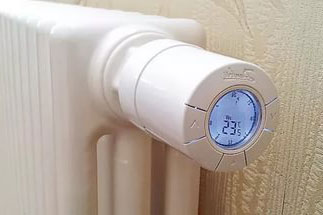
Adjustment with three-way valves
 The use of a three-way valve to regulate the temperature of radiators is rare in practice, since if we compare the price of one "three-way valve" and a conventional radiator regulator, the latter will be cheaper. But still a few words about this method need to be written.
The use of a three-way valve to regulate the temperature of radiators is rare in practice, since if we compare the price of one "three-way valve" and a conventional radiator regulator, the latter will be cheaper. But still a few words about this method need to be written.
A three-way valve is installed on the radiator supply pipe, however, the following diagram visually shows this:
The same thermal head, which has already been mentioned above, is screwed onto the three-way valve, on which the required parameters are set. 
Perhaps this is all the exhaustive material on the topic of adjusting heating batteries for an apartment building and a private house. We hope it was helpful to you.
«>
Why do you need to adjust
The main factors explaining the need to change the heating level of batteries using locking mechanisms, electronics:
- Free movement of hot water through pipes and inside radiators. Air pockets can form in the heating system. For this reason, the coolant stops heating the batteries, since it gradually cools down. As a result, the microclimate in the room becomes less comfortable, and over time the room cools down. To keep the pipes warm, locking mechanisms mounted on radiators are used.
- Adjusting the temperature of the batteries makes it possible to reduce the cost of heating your home. If the rooms are too hot, by changing the position of the valves on the radiators, you can reduce costs by 25%. Moreover, a decrease in the heating temperature of the batteries by 1 ° C provides a saving of 6%.
- In the case when the radiators strongly heat the air in the apartment, you often have to open the windows. In winter, it is not advisable to do this, because you can catch a cold. In order not to have to constantly open windows in order to normalize the microclimate in the room, regulators should be installed on the batteries.
- It becomes possible to change the heating temperature of the radiators at your own discretion, and individual parameters are set in each room.
Why are there taps on radiators?
Each heater is a separate element of the system that needs adjustment and periodic maintenance. If, however, the flow of coolant through the batteries is controlled depending on the need for heat, then good results can be achieved in terms of energy savings. That is, radiator valves and taps for heating are designed to solve such problems:
- Complete isolation of the heating device from the system.
- Restriction of the coolant flow through the battery.
- Change in coolant flow depending on external conditions.
- Bleeding air from the radiator and pipe network.
There are many situations in which it is difficult to do without disconnecting the battery. For example, a properly functioning central heating in the middle of spring, when it is already warm outside, and the apartment is just hot. Another case is the need to remove the heater in order to replace, flush or repair. In the absence of shutoff valves, it becomes problematic to carry out any action with the radiator.
Valves put on batteries in retro style
Restriction of the flowing coolant is carried out in order to balance individual heating in a private house or apartment
No matter what type of heating system you have, without balancing with valves, the first batteries will always receive more water than the last ones. To limit the coolant flow at the beginning of the network and thereby equalize all the devices with each other is the task of the control radiator fittings
Automatic control of the flow of the incoming coolant is a way to save energy used to heat the house. If each faucet on the heating battery maintains the set air temperature in the room, controlling the flow of water through the radiator, then in general the system will consume only the required amount of heat, no more. And that's a big savings.
Well, the problem of air release when filling the system or during operation is also solved by special air valves installed on all modern radiators. Below is a list of varieties of shut-off and control valves, listed in the same order as the tasks it solves:
- Semi-turn ball valves in straight and angle versions. They are made of brass, bronze or polypropylene with a metal insert.
- Balancing valves for radiators - straight and angled.
- Adjusting valves with thermal heads (thermostatic valves).
- Drain valves - automatic and manual.
For reference. Some home craftsmen use three-way mixing valves to connect heaters. But such a solution is unreasonably expensive and rarely used in practice.
Now we should consider in detail which taps are best placed on radiators in various conditions and circumstances. Some options are clearly shown in the video:
Valves and faucets
Such fittings are a heat exchanger of a locking device. This means that the radiator is adjusted by turning the tap / valve in the desired direction. If the valve is turned all the way 90 °, the water flow into the battery will no longer flow. To change the heating level of the heater, the locking mechanism is set to the half position. However, not all fittings have such an opportunity. Some faucets may leak after a short period of use in this position.
Installing shut-off valves allows you to manually control the heating system. The valve is cheap. This is the main advantage of such fittings. In addition, it is easy to operate, and no special knowledge is needed to change the microclimate. However, locking mechanisms also have disadvantages, for example, they are characterized by a low level of efficiency. The cooling rate of the battery is slow.
Stopcocks
A spherical design is used. First of all, it is customary to install them on a heating radiator in order to protect housing from coolant leakage. This type of valve has only two positions: open and closed. Its main task is to turn off the battery if such a need arises, for example, if there is a risk of flooding the apartment. For this reason, stopcocks are cut into the pipe in front of the radiator.
If the fitting is in the open position, the coolant circulates freely through the heating system and inside the battery. Such taps are used if the room is hot. Periodically, the batteries can be disconnected, which will reduce the value of the air temperature in the room.
However, ball locks must not be installed in the half position. With prolonged use, the risk of leakage increases in the area where the ball valve is located. This is due to the gradual damage to the locking element in the form of a ball, which is located inside the mechanism.
Manual valves
This group includes two types of fittings:
- Needle valve. Its advantage is the possibility of a half installation.Such fittings can be located in any convenient position: completely opens / closes the access of the coolant to the radiator, significantly or slightly reduces the volume of water in the heaters. However, needle valves also have a disadvantage. So, they are characterized by a reduced throughput. This means that after installing such fittings, even in a fully open position, the amount of coolant in the pipe at the battery inlet will be significantly reduced.
- Control valves. They are designed specifically to change the heating temperature of the batteries. The pluses include the ability to change the position at the discretion of the user. In addition, such fittings are reliable. It will not be necessary to frequently repair the valve if the structural elements are made of durable metal. There is a locking cone inside the valve. When the handle is turned in different directions, it rises or falls, which contributes to an increase / decrease in the area of the flow section.
Control valves for radiators
To manually adjust the operation of heating devices, use special valves. Such cranes are sold with direct or angular connection. The procedure for regulating heating batteries using these devices in manual mode is as follows.
Turning the valve lowers or raises the stopper cone. In the closed position, the coolant flow is completely blocked. Moving up or down, the cone regulates to a greater or lesser extent the amount of circulating water.
Due to this principle of operation, such valves are also called "mechanical temperature controllers". They are installed on threaded batteries, and connected to pipes with fittings, most often of a crimp type.
The control valve used for heating appliances has the following advantages:
- the device is reliable, it is not dangerous for blockages and fine abrasive particles present in the coolant - this applies only to high-quality products in which the valve cone is made of metal and carefully processed;
- the product is affordable.
The control valves also have disadvantages - every time you use the device, you have to change its position manually and for this reason it is rather problematic to maintain a stable temperature regime.
For someone who is not satisfied with this order, and he thinks about how to regulate the temperature of the heating battery by another method, the use of automatic products is more suitable, which allows you to control the degree of heating of the radiators.
Ball Valves
Valves are cheap, but at the same time inefficient control devices. Ball valves are often installed at the inlet to the radiator, with the help of which they regulate the flow of water.
But this equipment also has other functionality - shutoff valves. Valves are used to completely shut off the flow of coolant in the system. For example, in the event of a heater leak, ball valves located at the inlet and outlet of the radiator allow repairs to be made without stopping the heat supply and draining the liquid.
Ball valves do not adjust the heating batteries in the apartment. They have only two positions - fully closed and open. An intermediate location only brings harm.
The fact is that inside such a tap there is a ball with a hole, which in its normal position is not threatened by anything, but in all other situations, the solid particles present in the coolant grind it down and pieces break off from it. As a result, the faucet will not be airtight and in the “closed” position water will continue to flow into the battery, which is fraught with big trouble in the event of a device leak.
If one of the property owners has decided to make control of heating batteries using ball valves, it must be remembered that they should be installed correctly.
This method is usually used in apartment buildings. If the wiring is single-pipe vertical, then the hot water pipe enters the room through the ceiling and a radiator is connected to it (read: “Proper adjustment of heating batteries in the apartment - comfort in the house and saving money”). The pipeline departs from the second entrance to the device and goes through the floor to the lower room.
In this case, it is necessary to properly install the valves, since the installation of a bypass is mandatory. The bypass pipe is needed so that when the liquid flow to the radiator is closed, the coolant continues to circulate in the common house system.
In some situations, the tap is placed on the bypass in order to change the amount of water passing through it and thereby adjust the heat transfer of the battery. To ensure greater reliability of the heating system, at least three taps are installed: two will be cut-off on the radiator and function normally, and the third will become regulating.
But here we must not forget in what position the devices are located. Otherwise, you can completely block the riser and you will not be able to avoid both the cold in the apartment, as well as unpleasant showdowns with neighbors and representatives of the management company.
Manual controls
Manual adjustment is carried out by means of a valve installed on the pipes supplying or discharging the coolant from the battery. The scheme, depending on the type of heating system (two-pipe or single-pipe), is slightly different:
Everything is simple here, it became hot - they closed the valve, it was cold - they opened it.
The radiator is additionally equipped with one more tap so that in the event of a leak on the radiator, it can be eliminated or the radiator replaced without shutting down the entire system.
How not to regulate the temperature of the radiator
Perhaps you need to focus your attention on one important thing. That it is necessary to install valves, not ball valves, to adjust radiators
Often, two ball valves are installed on radiators in case of emergency situations when this area requires urgent repairs. These taps make it possible to make repairs without draining the heating system or blocking the common riser of the house. Some regulate batteries with them. This is not worth doing.
Ball valves are shut-off valves, it has only two working positions, it is open or closed. It does not have any intermediate working positions. Yes, it will reduce the rate of passage of the coolant through the radiator as much as you need it. But his days will be numbered. The fact is, when the position of this tap is between “open” and “closed”, the ball covered with a protective layer begins to collapse with small particles in the form of sand, scale, rust, located in the coolant. Especially in the central heating coolant. In places of the disturbed layer, lime deposits, rust, and so on begin to be deposited. 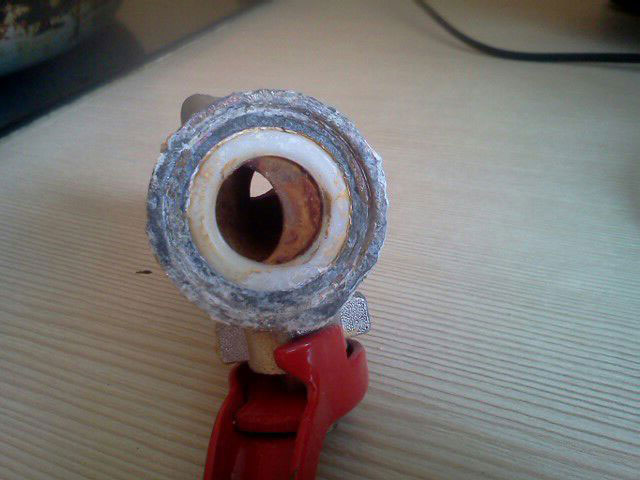
Which valves to use for adjustment
To regulate the temperature of the radiators, special radiator control valves are used. They are specially designed for use in heating systems, both individual and central. They are resistant to coolant containing solids and are also capable of high flow rates. They are available with both direct and angled connections.
These valves are reliable, durable, affordable, effectively cope with their intended purpose. The only disadvantage of manual regulators is periodic monitoring and adjustment. It is necessary to twist from time to time, then to a greater, then to a lesser extent, depending on the climate outside, the temperature of the coolant and the room.
Summarizing
You can regulate heating batteries using several types of devices, but experts believe that the best solution would be to use special control valves. Such products are manual taps and automated products - thermostats, and only in some cases it is possible to use a three-way valve with a thermal head.
In high-rise apartments with central heating, it is better to give preference to control valves or a three-way valve. As for individual heat supply systems, then the problem of how to reduce the temperature of the coolant in the heating battery is solved using thermostats.
If the owner of the apartment still prefers automatic adjustment of radiators, then a filter should be installed before the thermostat - it will trap most of the various impurities.
So the temperature in different rooms of a residential building for a comfortable stay in it should be different. For example, the bedroom should be cooler than, for example, the living room. Therefore, already at the stage of designing and installing a heating system, it should be possible to do this. And if this has not been done, then if necessary, it must be done.
But before proceeding with the modernization of the heating system, you need to understand one circumstance for yourself. Adjustment of radiators from the initial temperature is possible only in the direction of lowering the temperature. Raise higher than it was impossible to regulators.
